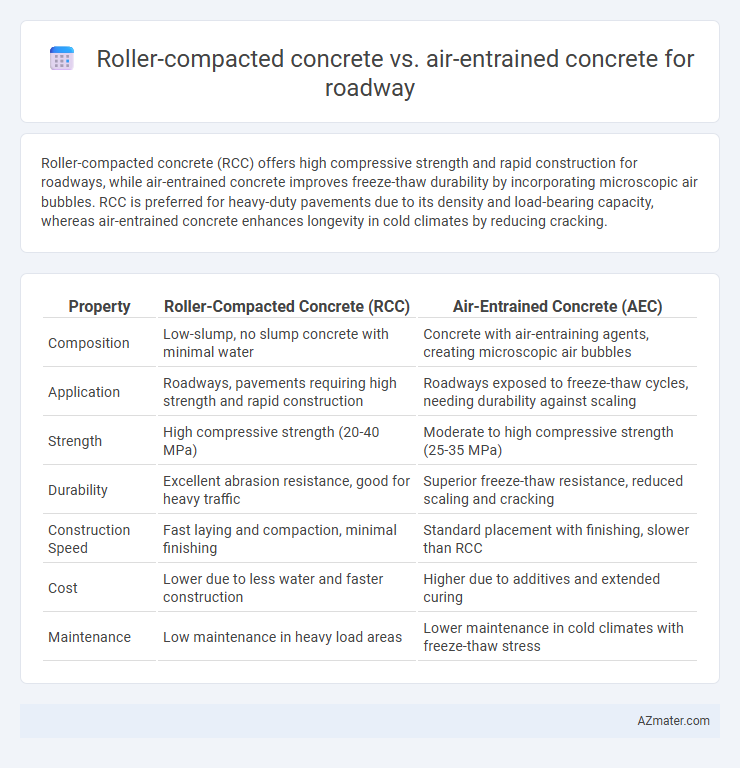Roller-compacted concrete (RCC) offers high compressive strength and rapid construction for roadways, while air-entrained concrete improves freeze-thaw durability by incorporating microscopic air bubbles. RCC is preferred for heavy-duty pavements due to its density and load-bearing capacity, whereas air-entrained concrete enhances longevity in cold climates by reducing cracking.
Table of Comparison
| Property | Roller-Compacted Concrete (RCC) | Air-Entrained Concrete (AEC) |
|---|---|---|
| Composition | Low-slump, no slump concrete with minimal water | Concrete with air-entraining agents, creating microscopic air bubbles |
| Application | Roadways, pavements requiring high strength and rapid construction | Roadways exposed to freeze-thaw cycles, needing durability against scaling |
| Strength | High compressive strength (20-40 MPa) | Moderate to high compressive strength (25-35 MPa) |
| Durability | Excellent abrasion resistance, good for heavy traffic | Superior freeze-thaw resistance, reduced scaling and cracking |
| Construction Speed | Fast laying and compaction, minimal finishing | Standard placement with finishing, slower than RCC |
| Cost | Lower due to less water and faster construction | Higher due to additives and extended curing |
| Maintenance | Low maintenance in heavy load areas | Lower maintenance in cold climates with freeze-thaw stress |
Introduction to Concrete Types in Roadway Construction
Roller-compacted concrete (RCC) is a dense, no-slump concrete mix optimized for rapid placement and compaction in high-volume roadway construction, providing enhanced durability and load-bearing capacity. Air-entrained concrete incorporates microscopic air bubbles to improve freeze-thaw resistance, crucial for roadways in climates with frequent temperature fluctuations. Both concrete types offer distinct advantages in pavement performance, with RCC favored for fast-track projects and air-entrained concrete preferred for enhanced weather resilience.
Understanding Roller-Compacted Concrete (RCC)
Roller-compacted concrete (RCC) is a rigid pavement material known for its high density and load-bearing capacity, achieved through a zero-slump concrete mixture compacted by vibratory rollers. Unlike air-entrained concrete, RCC contains minimal air voids, which enhances its strength and durability but may reduce freeze-thaw resistance compared to air-entrained variants. RCC's rapid placement and cost-effectiveness make it ideal for heavy-duty roadways requiring minimal maintenance and long service life.
Overview of Air-Entrained Concrete
Air-entrained concrete contains microscopic air bubbles introduced through air-entraining agents, enhancing its resistance to freeze-thaw cycles and improving durability in cold climates. This type of concrete is commonly used for roadways exposed to harsh weather conditions, reducing surface scaling and extending pavement lifespan. Its improved workability and reduced permeability make it a preferred choice for maintaining roadway integrity under cyclic freezing and thawing stresses.
Key Material Properties Comparison
Roller-compacted concrete (RCC) features a low cement content and zero-slump consistency, resulting in high-density and rapid strength gain, ideal for heavy-duty roadways requiring durability and minimal shrinkage. Air-entrained concrete incorporates microscopic air bubbles that enhance freeze-thaw resistance by improving durability and reducing scaling under harsh weather conditions. While RCC excels in load-bearing capacity and speed of construction, air-entrained concrete optimizes long-term resilience in cold climates, making material choice critical based on specific environmental and structural demands.
Performance in Varying Climates
Roller-compacted concrete (RCC) offers superior durability and load-bearing capacity in high-traffic roadways with rapid construction timelines, excelling in hot and dry climates due to its low water content and high density. Air-entrained concrete enhances freeze-thaw resistance by incorporating microscopic air bubbles, making it highly effective for roadways in cold, wet, and freeze-prone regions where seasonal temperature fluctuations cause frequent freeze-thaw cycles. Selecting RCC or air-entrained concrete depends on climate-specific performance requirements, with RCC favored for strength and speed in warm environments and air-entrained concrete preferred for sustainability against frost damage in cold climates.
Construction Techniques and Equipment Required
Roller-compacted concrete (RCC) utilizes heavy-duty rollers and pavers for rapid placement and compaction, making it ideal for large-scale roadway construction with high durability demands. Air-entrained concrete requires precise mixing equipment to introduce stable air voids, enhancing freeze-thaw resistance but involves traditional slipform pavers for smooth finishing. RCC's construction techniques emphasize low-slump concrete placement with vibratory rollers, while air-entrained concrete relies on controlled curing and finishing processes to maintain structural integrity in variable weather conditions.
Durability and Longevity in Road Applications
Roller-compacted concrete (RCC) offers exceptional durability and longevity in road applications due to its dense, low-permeability matrix, which resists abrasion and heavy traffic loads effectively. Air-entrained concrete improves durability primarily by enhancing freeze-thaw resistance through microscopic air voids, making it ideal for cold climates but less resistant to mechanical wear compared to RCC. For long-lasting roadways exposed to heavy loads and abrasion, RCC provides superior performance, while air-entrained concrete excels in maintaining structural integrity under freeze-thaw cycles.
Cost Considerations and Life-Cycle Analysis
Roller-compacted concrete (RCC) offers lower initial construction costs due to faster placement and reduced formwork compared to air-entrained concrete, which requires more precise mixing and curing processes. Life-cycle analysis indicates RCC often results in reduced maintenance expenses and longer service life in heavy traffic applications, while air-entrained concrete provides enhanced freeze-thaw durability, potentially lowering repair costs in colder climates. Selecting between RCC and air-entrained concrete depends on project-specific factors including environmental conditions, anticipated traffic loads, and budget constraints to optimize long-term cost efficiency.
Environmental Impact and Sustainability Factors
Roller-compacted concrete (RCC) offers significant environmental benefits due to its lower cement content and reduced water usage, resulting in decreased carbon emissions during production. Air-entrained concrete incorporates microscopic air bubbles improving freeze-thaw durability, minimizing maintenance and extending pavement lifespan, which contributes to sustainability by reducing resource consumption. RCC's rapid construction process also lowers energy use and traffic disruptions, enhancing overall roadway sustainability compared to traditional air-entrained concrete applications.
Best Use Cases: RCC vs Air-Entrained Concrete
Roller-compacted concrete (RCC) excels in heavy-duty roadways and industrial pavements due to its high compressive strength, rapid construction, and durability under heavy traffic loads. Air-entrained concrete is best suited for roads in freeze-thaw environments, enhancing durability by increasing resistance to scaling and cracking from temperature fluctuations. Choosing RCC is optimal for fast-track projects requiring minimal downtime, while air-entrained mix is ideal for long-term performance in cold climates.

Infographic: Roller-compacted concrete vs Air-entrained concrete for Roadway
 azmater.com
azmater.com